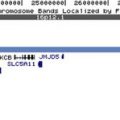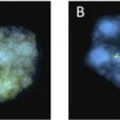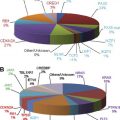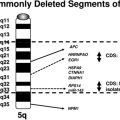Laboratory Aspects of Prenatal Microarray Analysis
b Department of Pathology, University of Utah Health Sciences Center, Salt Lake City, UT 84108, USA
Keywords
• Array comparative genomic hybridization • Prenatal microarrays • Maternal cell contamination • Amniocytes • Chorionic villi • Abnormal ultrasound
The recent development and clinical implementation of array comparative genomic hybridization (aCGH) or microarrays has resulted in the most rapid and significant changes in the field of cytogenetics since the development of reliable chromosome banding techniques in the 1970s. aCGH detects gains and losses, which are referred to as copy number variations (CNVs), the size of which is determined by the array design1 (see “Prenatal Array Design” section).
The widespread use of arrays for postnatal cases has revealed many additional abnormalities that were not detectable by G-banded analysis and has altered the view of the extent of the causes of developmental delay, intellectual disability, multiple congenital anomalies, and autism. This has led to the recognition of new microdeletion and microduplication syndromes (see the article by Deak and colleagues elsewhere in this issue), and that the segmental duplication structure of the genome results in nonallelic homologous recombination (NAHR) that causes these genomic disorders.2–5 Analysis of multiple published studies shows that arrays increase the detection rate of clinically significant abnormalities above standard karyotyping by 10% to 15%6 and has led to the recommendation that microarray analysis should be a first-tier test.6,7 Microarrays also have an added benefit of providing a quantitative assessment of the genome, as opposed to the more subjective, qualitative approach with the historical standard of G-banded karyotypes, thus reducing errors or false-negative results. These false-negative results occur more frequently than most clinicians are aware of and are seen in both postnatal and prenatal studies.
The current use of prenatal aCGH has been mostly limited to follow-up of a normal traditional karyotype in cases with an abnormal ultrasound, usually associated with multiple congenital anomalies, and for the further definition of cytogenetic abnormalities, such as unbalanced translocations, marker chromosomes, and checking for losses/gains at the breakpoints of reciprocal translocations. However, the yield for specific ultrasound abnormalities and other indications, such as maternal serum screen positive cases and advanced maternal age (AMA), has not been defined. Therefore, more studies are needed before aCGH becomes a first-tier test for prenatal genetic diagnosis. There is no consensus on what are we trying to achieve in prenatal genetic diagnosis owing to these recent changes in technology. Until recently, the range of genetic abnormalities had been defined by maternal serum screening programs, which includes trisomy 21 and other major aneuploidies. This large-genome-rearrangement view has led some to argue for the use of more rapid aneuploidy screens (fluorescence in situ hybridization [FISH], quantitative fluorescent polymerase chain reaction [QF-PCR], multiplex ligation-dependent probe amplification [MLPA]), and even forgoing traditional karyotype analysis if ultrasound findings are normal, as a cost-effective and adequate testing strategy in the current climate of increasing health care costs.8,9 But this approach does not allow detection of the newer microdeletion/microduplication syndromes that have been discovered recently, and thus will not impact many of the cases of developmental delay, intellectual disability, multiple congenital anomalies, and autism that are seen in the postnatal population.2 There is currently no way to find and concentrate these newer abnormalities in the prenatal population, as maternal serum screening has done for trisomy 21 and other aneuploidies.
One of the major concerns for the use of aCGH in the prenatal genetic diagnosis is the findings of variants of unknown/uncertain/unclear significance10,11 (the term variant of unknown significance [VUS] is used in this article). Many clinicians and genetic counselors would like to keep the VUS to a minimum in prenatal cases. Unlike prenatal cases, postnatal cases with a VUS can wait for the accumulation of evidence that can demonstrate correlation or greatly reduce the likelihood of clinical significance over several months or years as additional studies are completed and published. One of the key steps for determining the clinical significance of a postnatal VUS is not the determination of inheritance, but rather the comparison of the frequencies of a CNV in a patient and normal control populations.3,4 However, with current databases this approach is at present not possible for many CNVs, and it may not be efficient with the limited time available in the context of prenatal diagnosis.
There have been several recent reviews on the role of aCGH in prenatal studies and the reader may wish to consult these for other details not covered in this review.10,12–14
Prenatal Sample Types and Laboratory Processing
Amniotic fluid cells, or amniocytes, obtained by amniocentesis, and chorionic villus cells, obtained by transcervical or transabdominal sampling, are the main source of cells for prenatal chromosome and microarray analysis.15,16 The cells obtained may be used for direct analysis or set up in culture to get dividing cells and to increase the total number of cells available for testing.
Amniocytes
The experience gained over the years for use in traditional chromosome and FISH analyses for uncultured and cultured cells is very useful for aCGH studies.17 Amniocyte quantity is assessed after centrifugation and by gross examination of the cell pellet. This also allows for the assessment of the amount of blood present in the sample, usually of maternal origin. Based on examination of samples used for classic cytogenetics and for rapid aneuploidy assays, the cell pellet size varies from sample to sample and by gestational age (generally increasing with increasing gestational age).
Chorionic Villi
The trophoblasts are not as closely representative of the fetus as are the mesenchymal core cells. In addition, both layers may also have chromosomal changes that are not seen in the fetus, referred to as confined placental mosaicism (CPM).18 For cytogenetic analysis, if there are discrepancies between the direct and culture results, an amniocentesis is often performed, as amniocytes are usually more representative of the fetus. The algorithm to use for possible mosaicism or CPM with aCGH has not been established because of limited published studies with CVS, but the lessons learned from classic cytogenetics are likely to be the most important guide (eg, see Refs.19,20).
Maternal Cell Contamination
In contrast to classic cytogenetic analysis, DNA-based testing for MCC (usually STR-based markers) is routinely performed in many laboratories for molecular mutation detection of single genes in prenatal diagnosis. The risk for MCC is especially of concern when PCR-based tests are involved, owing to the risk of preferential amplification and over-representation of maternal DNA.21,22
As many view aCGH as a cytogenetic test, there has been a tendency to rarely request MCC on most prenatal aCGH tests, especially those involving amniocytes. ACGH is currently performed after traditional cytogenetic analysis and requires the additional expansion of cultures to obtain sufficient DNA, and the length of time in culture and the amount of subculturing can significantly expand an initial low level of maternal cells. Table 1 presents some data from our laboratory (Signature Genomics) over a period of several months and shows that the rate of MCC was approximately 1% for amniocyte cultures and approximately 4% for CVS cultures. As expected, there is a higher level of MCC in CVS cultures than in amniocyte cultures.
Table 1 Detection of MCC in 466 prenatal samples
| Total Cases | MCC Detected (%) | |
| Cultured amniocytes | 327 | 3 (0.9) |
| Cultured CVS | 139 | 6 (4.3) |
Does the presence of any level of MCC potentially invalidate the aCGH result or can copy number gains or losses still be detected accurately in the presence of various levels of MCC? There are no published studies that systematically examine the effects of different levels of MCC on different sized CNVs in aCGH. A potential source of information is studies of mosaicism, and these suggest that levels of a second cell line as low as 10% may be occasionally be detected; however, more consistent detection is in the 20% to 30% range.23–25 This information implies that if an abnormality is present, it may still be detected even in the presence of significant MCC. But a more important question may be at what level of MCC is an abnormality covered up and not detected? Does this differ for deletions versus duplications and for CNVs of different sizes? For example, is a smaller deletion covered up by a lower percentage of MCC than a larger deletion?
Samples from pregnancies with oligohydramnios appear to have a higher risk for MCC, where approximately 10% of cases obtained by amniocentesis may have overwhelming MCC.26 Such samples usually do not show evidence of blood contamination and the origin and type of maternal cell is not clear.
Stay updated, free articles. Join our Telegram channel

Full access? Get Clinical Tree








